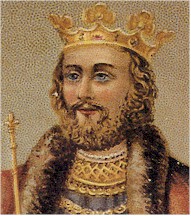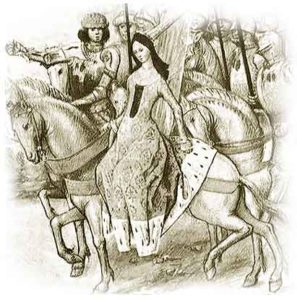 Chapter 10 Lesson Questions: Copy and paste into an email, add your answers, then send to the School with Born in Blood 10in the subject line.
Chapter 10 Lesson Questions: Copy and paste into an email, add your answers, then send to the School with Born in Blood 10in the subject line.
1. T/F: After the death of his father King Edward I, the English monarchy passed to his son, Edward II. King Edward II’s first official act as monarch was to kill Robert the Bruce of Scotland.
2. T/F: While Edward II sought out his favorite, his barons gained control of the Curia Regis, the kings council, and created a governing committee called the lords ordainers.”
3. Who started the antagonism that set the tone in the English court for the next five years? And how did he do this? Answer: Piers Gavestone of Gascony, he was King Edward II’s favorite who took royal advantage of the king, with his incessant demands for more wealth and power, and by using his wit and facility with words to mock the nobles at court.
4. What was the reaction of Edward II to the charges laid against the Templars?
5. T/F: In England the one institution that did not exist and in which England had resisted was that of the Inquisition.
6. After Edward II finally had to succumb to the Popes demands to torture the Templars, Edward II placed restrictions on the Popes interrogation/torture team. Name those restrictions.
7. Under Maria Theresa in the 18th century, tortures to be used for questioning became standardized by way of degrees. What were the degrees.
8. Multiple Choice: Anyone passing the Third Degree of the Question was considered:
A. Possessed by the Devil
B. Judged innocent and released
C. Beheaded on the spot
D. All of the above
9. Fill in the Blanks: It was conceded that this cord might have been a dividing line defining the zones of ________,” a device invented by St. Bernard of __________ for holy orders.
10. Where in Scotland did Robert the Bruce finally win the freedom of the Scots?
11. What did it mean to be an out-law in England?
12. Write a short summary explaining your own thoughts as to King EdwardII’s imprisonment and murder. Did the Queen ultimately commit treason? Was the king deserving of such treatment? (Be sure to read the article below).
SheWolf of France (Isabella, daughter of Philip IV of France and Edward’sII’s Queen of England). From http://www.zip.com.au/~lnbdds/home/shewolf.htm
 THE SHE-WOLF OF FRANCE
THE SHE-WOLF OF FRANCE
[This computer enhanced image below right is of Queen Isabella riding triumphantly into Oxford in 1327. It comes from the ‘Chronicle of the Counts of Flanders’ made in the 15th Century by an artist who worked for Mary of Burgundy. (Holkam MS)]
When Edward III in 1337 quartered the lilies of France with the arms of England on his royal standard, he set in motion a series of victories and disasters which historians were later to call ‘The Hundred Years War’.
King Edward II of England, married (1308) Isabella of France. She was the daughter of King Philip IV – the Fair (d. 1314) and the sister of his three successors, Louis X – le Hutin, Philip V – le Long and Charles IV – the Fair.Her mother was Joanna of Navarre.
She was first known as Isabella the Fair, and later as the She-wolf of France.She had been promised as the bride of Edward I’s son – Edward II. She married Edward in Boulogne and eventually left France for her new life in England.
When she landed at Dover she was met by the powerful courtier, Piers Gaveston,to whom Edward had entrusted the “care” of England in his absences. It became immediately obvious to Isabella that Edward and Gaveston enjoyed a much closerr elationship than might be tolerable for a wife – on top of which she also discovered that Edward had given Gaveston jewellery – jewellery that had been a wedding gift to her from her father. She immediately complained to her father but there was little he could do.
Isabella remained loyal however and when Edward increasingly antagonised the English nobles over his choice of “friends” she even acted as a mediator between the conflicting parties. Isabella also accompanied Edward when he went to war with Scotland. She was almost captured and her near escape allied to her acknowledged skills as a mediator made her a popular figure.
She gave birth to a son – the future Edward III – in 1312 at Windsor. She bore another son in 1314 and a daughter in 1316. However, her husband was becoming too unpopular to maintain effective government. Gaveston was banished in an attempt to free Edward from his grasp, but he was soon recalled. Eventually however, Edward was persuaded to abandon him and he was tried and executed.Replacing Gaveston were the Despensers (father and son) who saw Edward’s patronage as the potential for great wealth and power; but by this time Isabella had endured about as much as she was prepared to endure.
During Edward’s reign, England suffered a series of baronial conflicts, civil wars that factionalised the various political elements and it was during one such period of civil strife that, whilst awaiting the birth of her childi n the Tower of London, she encountered Roger Mortimer, Lord of Chirk and his nephew, also named Roger – both imprisoned there under sentence of death.The older Mortimer died from starvation and the death sentence on Roger Mortimer,the nephew, was postponed. He managed to escape and fled to France – possibly aided by Isabella herself who had fallen in love with him. In France, Mortimer pleaded on Isabella’s behalf to the then King – her second brother, PhilipV – who immediately acted against Edward, confiscating his French possessions.
Isabella was sent to France to mediate between her brother and her husband but as soon as she was settled there she requested that her fifteen year old son, Edward, be sent to France to pledge allegiance to her brother the King and then, when he arrived in France, she announced that neither of them would return to England until the Despensers had been banished. Edward retaliated by writing letters to France and referring to Isabella’s adulterous liaison with Mortimer. On reading these letters the King of France refused to support his sister.
Isabella turned to her lover, Mortimer, for support. They raised an army and landed in England in 1326, with her son and with Sir John of Hainault the uncle of Philippa of Hainault, the future wife of her son Edward – some sources say she was accompanied by Lord William of Hainault the father of Philippa – and almost 3,000 men. Many in England also rallied to her cause.Edward tried to escape but he was captured. The Despensers were subsequently executed and Edward II was formally deposed. His son was acknowledged as Edward III but he was under age and so Mortimer and Isabella became Regents.For some three years, they were supreme. During this time, Edward II was cruelly murdered (a red hot poker was thrust into his bowels) at Berkeley Castle and his widow Isabella immediately arranged the marriage of Edward III to Philippa of Hainault; but by this time, such popularity that she had enjoyed had begun to wane – especially so after the death of her husband.
Edward III seized power. He had Mortimer arrested and then executed which is said to have unbalanced the mind of his mother. In 1330 her income was limited and she was confined to Castle Rising (Norfolk) where, for a period of some seven years, she lived a virtual prisoner under house arrest; but in 1337 her income was restored as Charles IV, King of France – the last of Isabella’s brothers to be King – died at Vincennes, leaving no direct heir and the throne had been seized by his Regent, Robert de Valois. A new French dynasty was in the making but Edward III decided to claim to the throne of France (ignoring Salic Law) through his mother as the dead King’s sister,thus precipitating the Hundred Years War. As for Isabella – she lived the last twenty eight years of her life in ‘comfortable retirement’ and was buried beside her lover, Roger Mortimer.
[Katia adds: This is the beautiful young queen in the movie Braveheart. She comes over from France to marry England’s Prince of Wales, only to find out he has a gay lover. In the movie, King Edward Longshanks pushes the homosexual lover of the Prince out a window. In real life he lived much longer nearly ruining England because of his influence on the King. Details written in a lively manner here: EdwardII: The Gay Blade
It also occurs to me when thinking of who this woman’s father was (the infamous Philip IV “the Fair” who arrested the Templars!) that England’s royal family then became descendants of him. He is the grandfather of Edward III and therefore great-grandfather of the famous military commander and warrior extraordinaire,Edward the Black Prince. Earlier in this lesson series we met Richard II, the young boy who stopped the Peasant’s Revolt with his bravery. He is the Black Prince’s son, remember, but his uncles control him until finally his cousin Henry takes the throne from him.]

